Space Shuttle Launch Complex 39-B Construction Photos
Page 7
GOX Arm Strongback Lift 3 (Original Scan)
Some day I'll tell you a tale of $40,000.00 worth of bolts, the cost of which we had to eat, because they spec'd out aircraft bolts instead of the A325 bolts that the entirety of the rest of the towers were fastened together with. Bolts that held the swing arms to the FSS. Again, Aircraft Bolts. Yikes! But not now. There's also a psychotic story involving the GOX Arm hinges, too. But again, not now.
The first three of these photos were taken from out on the end of the Hammerhead Crane, looking back toward the FSS, leaning out as far as I could (no safety harness, no nothing), past the edge of the crane, to give myself an unobstructed view, and since I'm out at the very tip end of the hammerhead crane, which extends past the edge of the sensible pad deck to a location above the flame trench, my elevation above that which would kill me if I fell, really was 300 feet, just like it showed on the drawings. But like I said earlier, once you're up this high, fifty feet, one way or the other, really doesn't make any sensible difference.
Helluva view from out there on the end of that crane. Which was nowhere near as sturdy as it might appear in some photographs. You could feel it bounce up and down as you walked on it. Three hundred feet up, over the bottom of the Flame Trench. What fun!
These shots are all more or less self-explanatory, but the bottom right photo is interesting for two reasons:
Reason number one is that a close examination of the headache ball on that crane will cause you to realize that we really didn't have another inch to go on getting that strongback up any higher. We'd used up all the stick that crane had to give. But it worked, and that's what matters, right?
Reason number two is just that it's a neato angle, looking down the barrel, two-hundred and fifty feet back down to the crane cab on the pad deck. I've always liked this shot. I consider it to be one of the best pictures I've ever taken in my life, and I've taken hundreds of thousands (my previous camera finally died with a frame count of over two-hundred fifty-thousand, showing on the Exif data for the last frame it ever took).
Additional commentary below the image.
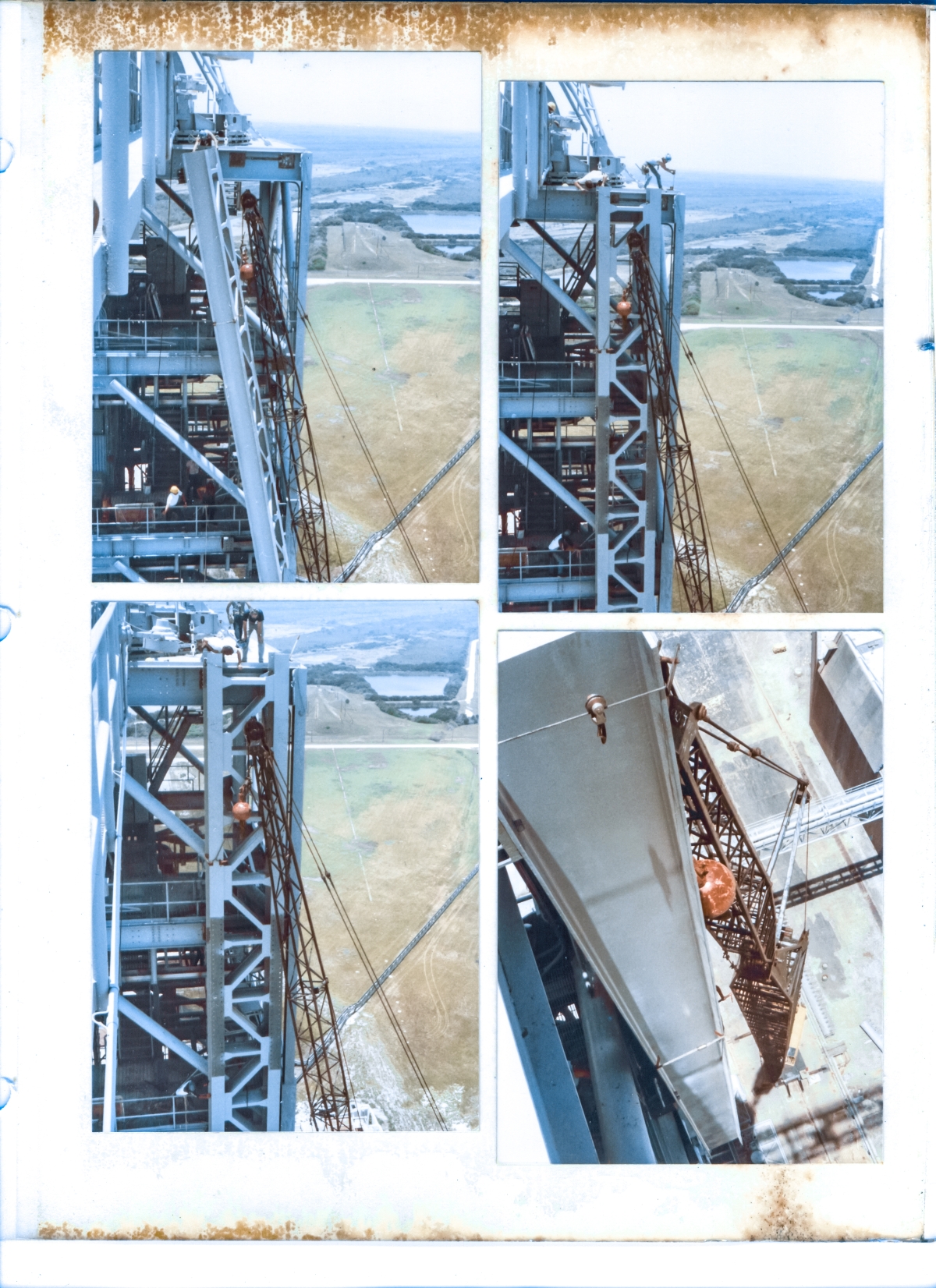
Top Left: (Full-size)
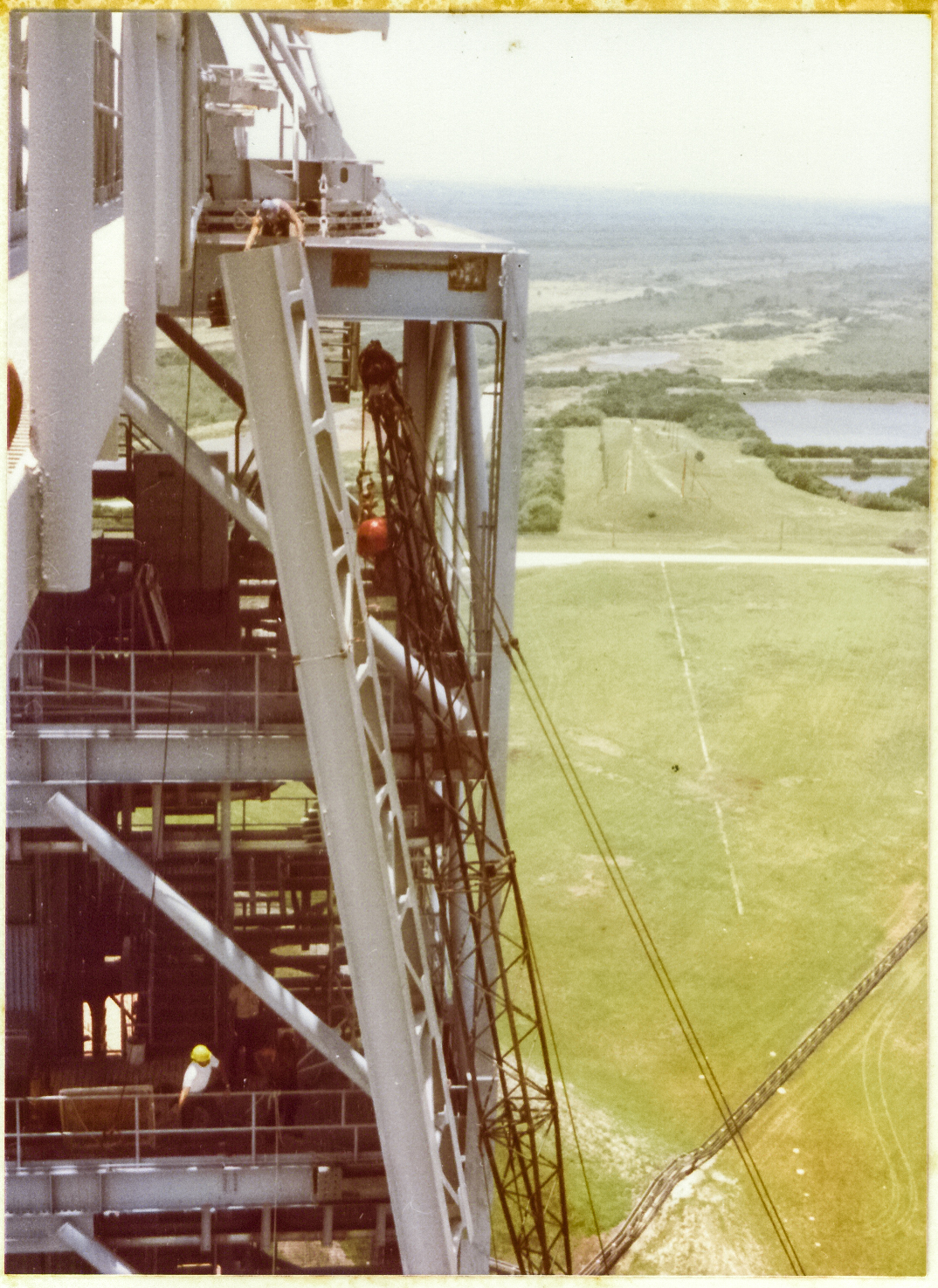
And by now you should understand the reason for the bizarre attachment of the lifting sling to a place above the headache ball, as well as the strange choice of locations for the attaching the lifting sling to the strongback. The goddamned crane didn't have enough boom to reach! So instead of going to the significant time and expense of getting a bigger crane, or outfitting this one with some more "stick" (presuming such a thing was even possible with this crane), they, being the masters of their craft that they were, sized things up closely and concluded that it could be done with what they had, and that, my friends, is the story of how you outbid your competition and still manage to come in under budget and ahead of schedule.
It was a thing of rare beauty to behold.
Ok, enough about that. Once again, there's a lot going on in these images, so zoom in and hang on, and here we go.
Right off the bat, no handrail up at the top of the FSS. The farthest goddamned "solid" ground above the pad deck, and no fucking handrail. Why?
Hammerhead crane, that's why. It rotates freely in a full circle, and the boom on that thing is just above the surface of the deck plates up on the 300 foot level at the very top of the FSS, and handrail, removable or otherwise, just ain't gonna cut it, and so the safety department gets to swallow nervously and write out some kind of waiver or other to negate some of the stuff in the OSHA (Occupational Safety and Health Administration) book, and then hope that nobody goes over the side from up there. There's room for 4-inch toe plate, and you can see it all around the perimeter, maybe half a foot or so inboard from the edge of the flange on the FSS framing steel, but that's it, that's all you get when you're walking around on the checkerplate up on the top of the FSS. Behind our ironworker, you can see that the hammerhead crane is secured pretty well with some hefty turnbuckles, so there will be no worries about someone inadvertently hitting the button, spinning the crane around in a circle, and sweeping everything and everybody clean off the top of the FSS, so that's comforting, right?
But let's get back to our ironworker. He's manually guiding the fucking strongback, bare-handed, repositioning it or some damn thing. Knees against the inside surface of that 4" toeplate, but otherwise hanging out over thinnest air while he's doing it. He needs to be able to move around, quickly, from one place to another up there, so no harness. Whoa! Pretty ballsy if you ask me. Of course, then again, I'm kinda hanging out a little too, between the toeplate and the lower bar of the handrail, trying to get a good angle on this shot from where I'm either crouched or laying down (cannot recall which, but it's probably laying down, which is somewhat safer) out on the far end of the boom on the hammerhead crane.
But I'm no ironworker. Never was, never will be. Not even close. Will never be able to give these people the full respect which they are due. Never.
Also, we can now get a good close look at the area on the FSS where the strongback is going to be attached, and all we can see is an area of bare metal, and no bolt-holes, which means the connection weldments on the strongback are themselves going to be welded to the framing steel on the FSS. So it's nice to have that little question answered, isn't it?
One level down, at the 280' elevation, that looks like it might be Wade, mostly hidden behind the strongback, keeping his usual eagle-eyed gaze upon things. Behind him over to the left, viewed nearly edge-on, leaning up against some damn thing or other, are a couple of floats, which are four foot square constructions of strong plywood and two-by-fours, that get hung by strong rope on the steel where welding or any other time-consuming activity is going to be done, that the ironworkers park themselves on to do the work that's being done in the area. Floats are alarming things that move around when you step on to them or step off of them, and the first time you do this it's kinda scary, but you get used to it soon enough and after a while, you may as well be sitting down on the sidewalk or something. Kinda funny how stuff like that works, and how quickly you get acclimated to things.
Behind those floats, pretty obscure in shadow, is a pretty tall electrical box. There's a story that goes with one of those boxes, involving work we had to do with it one day. Not sure if it's this electrical box, or maybe one just like it a few levels down on the FSS. Maybe later I'll tell you the story of the electrical box and the as-built drawings, and if I think to tell that little tale, I can only hope to remember that this picture is probably the only thing I've got which shows one of these deeply-obscure items well enough to help people understand the story. I hope.
One more level down, at the 260' elevation, I can see at least three more people, and the guy in the white shirt is controlling the crane by giving hand signals to the operator, who's squinting up into the sky from way the hell down there in his crane cab. To the left of our white-shirted ironworker, another float leans up against the handrail, ready to be hung out over an open drop of over 200 feet and tied to the structure where somebody can get out on it and get some goddamned work done.
And sure enough, if you look closely, you can see that the weldment that the bottom end of the strongback will be tying to, is already there, complete with bolt-holes, half-hidden by the strongback itself, on the FSS framing steel, just like we surmised that it had to be, back when we were examining the strongback when it was down there close to the ground. It's fun to be able to figure stuff like this out. I've never been one for regular everyday puzzles you solve for amusement, because when you solve a stupid puzzle, all you get is a solved puzzle, which seems like some pretty weak tea as far as a proper reward goes, but this stuff, well now you're talking. Solve one of these puzzles, and you get to do shit, or know shit, both of which I like a lot. But why they did it this way, with two weldments on the strongback, and one on the tower, I'm sure I'll never know. But one thing I do know, is that there was a reason. Shit like this is never a result of random chance. There's always a reason, and it's always a good reason, too. But in this instance, it's not for us to know.
Top Right: (Full-size)
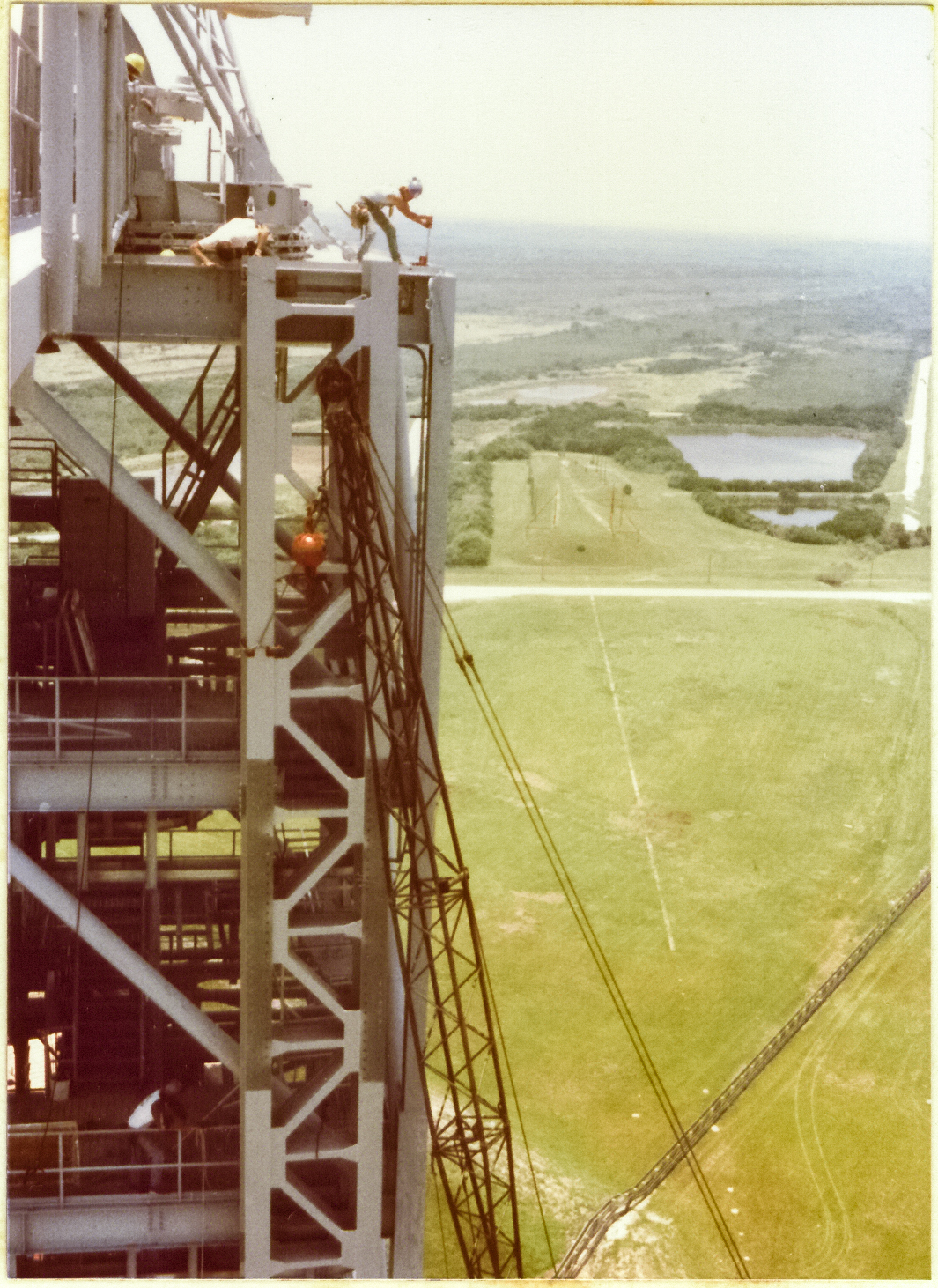
And now, by god, the headache ball is out of the way, the strongback has been rotated way the hell around over to the side of the crane jib, that last little bit of elevation has been gained, a sharp pair of eyes is hanging over the edge of the framing steel, missing nothing, and we're on the come-along blazing away with it, ratcheting that fucking strongback right into place, right where it belongs, using a goddamned crane that nobody else in the world would have been able to use to do this job. Pretty cool, huh?
Most of the people on the lower levels, including Wade, have moved on, and things once again have fallen back into routine (routine for ironworkers, not for mere mortals), and the work goes on apace.
Now that the strongback has been moved over some, back there in the shadows behind it, extending up and to the right from the electrical box I mentioned just above, you can see the ships ladder that takes you to the "roof" of the FSS, up at elevation 300'. You can't really see it in this image (or any of the others, either), but there's an intermediate landing that ships ladder brings you to, where you take an 90° turn to access the rest of the ladder, facing east now, which takes you up through a cutout in the checkerplate that covers the top of the FSS, and you just sort of climb on up and out, through that cutout, no handrails anywhere around to help you pull yourself through, or to steady you as you come up on top of the steel, far far above your distant surroundings, beneath a Florida Sky.
This whole area of the FSS provides spectacular view after spectacular view, and is drenched in that amazing juxtaposition of launch facilities, the endless (completely undeveloped!) lonesome shoreline of the Atlantic Ocean, and hundreds of thousands of acres of brutal swamp, which never seems like it should all go together as a unified whole, but in fact does so very well, with an extraordinarily pleasing aesthetic, and I was always mindful to stop, grab the time (whether it was being freely offered or not) and take that shit in, every single time I came up here. There's nothing whatsoever anywhere near the FSS at this elevation, so the views are completely unobstructed for a full three-hundred sixty degrees of distant horizon, all around you. You would never want to be caught out in any of that rough country, alone and on foot, but from up here, it was absolutely gorgeous. No picture I have taken does it the least scrap of justice. It is something else.
Bottom Left: (Full-size)
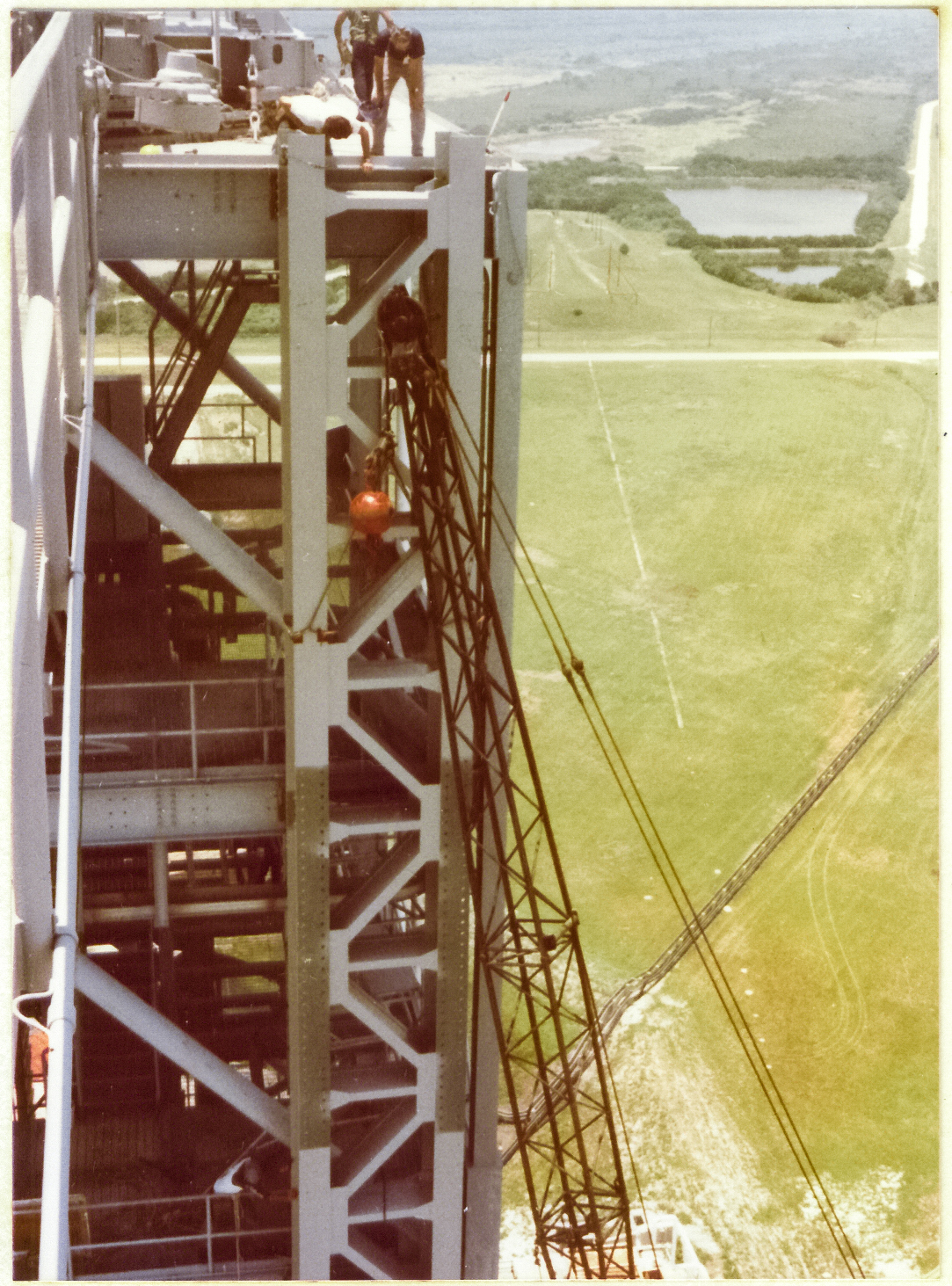
And now that we're dead nuts right where we belong, the come-along has been abandoned and its wire rope hangs slack, and Wade's right there too, verifying that everything is just so prior to moving forward.
Your photographer has come out from underneath the lower bar of the handrail, and is now merely leaning over the top of the handrail, in clear defiance of all previous imprecations to never do such a foolish and dangerous thing. Ah well... so it must be.
On the ground, far below, starting from behind the FSS and crane jib, you can see a run of cross-country piping on its supports, extending up and out of frame to the right. This run of pipe went to the big Lox tank over on the northwest edge of the pad area. Of note, just above the bottom margin of the frame, is a bit of a curve or bend in that run of pipe, which corresponds to an area of thinner grass, with more white sand showing through it. That "bend" is actually where the piping goes over a bit of a low rise in the ground, which you would never be able to recognize for what it actually is in this photograph, had I not told you. That low rise extends from the edge of the pad's concrete apron, all the way to the pad perimeter road on the west side, and covers a concrete tunnel. Which tunnel being an emergency egress route that runs from the old Apollo "Rubber Room" out and away from the pad.
Once upon a time, Jack Petty and I had, just for fun, gone down into the Rubber Room (which is quite the fascinating place, in and of itself), and while we were there, we decided to explore a bit further, with the intention of walking the full length of this tunnel, all the way out to the end.
Didn't happen.
The tunnel was still dimly-lit inside, but was otherwise completely abandoned, and we did not have to walk very far along it at all to be confronted with a floor that sloped gently downward until it was beneath some pretty nasty black standing-water, of unknown depth, hiding unknowable pitfalls and hazards, and with thoughts of aggressive cottonmouth moccasins, or perhaps thirty-pound diamondbacks lurching up at us from their unseen hiding places in the wet gloom, we very wisely decided to turn back, and return to the relative comfort of the Rubber Room.
Kinda wish I'd gone back, properly dressed for it, and taken the full walk, but I never did.
Sigh.
Bottom Right: (Full-size)
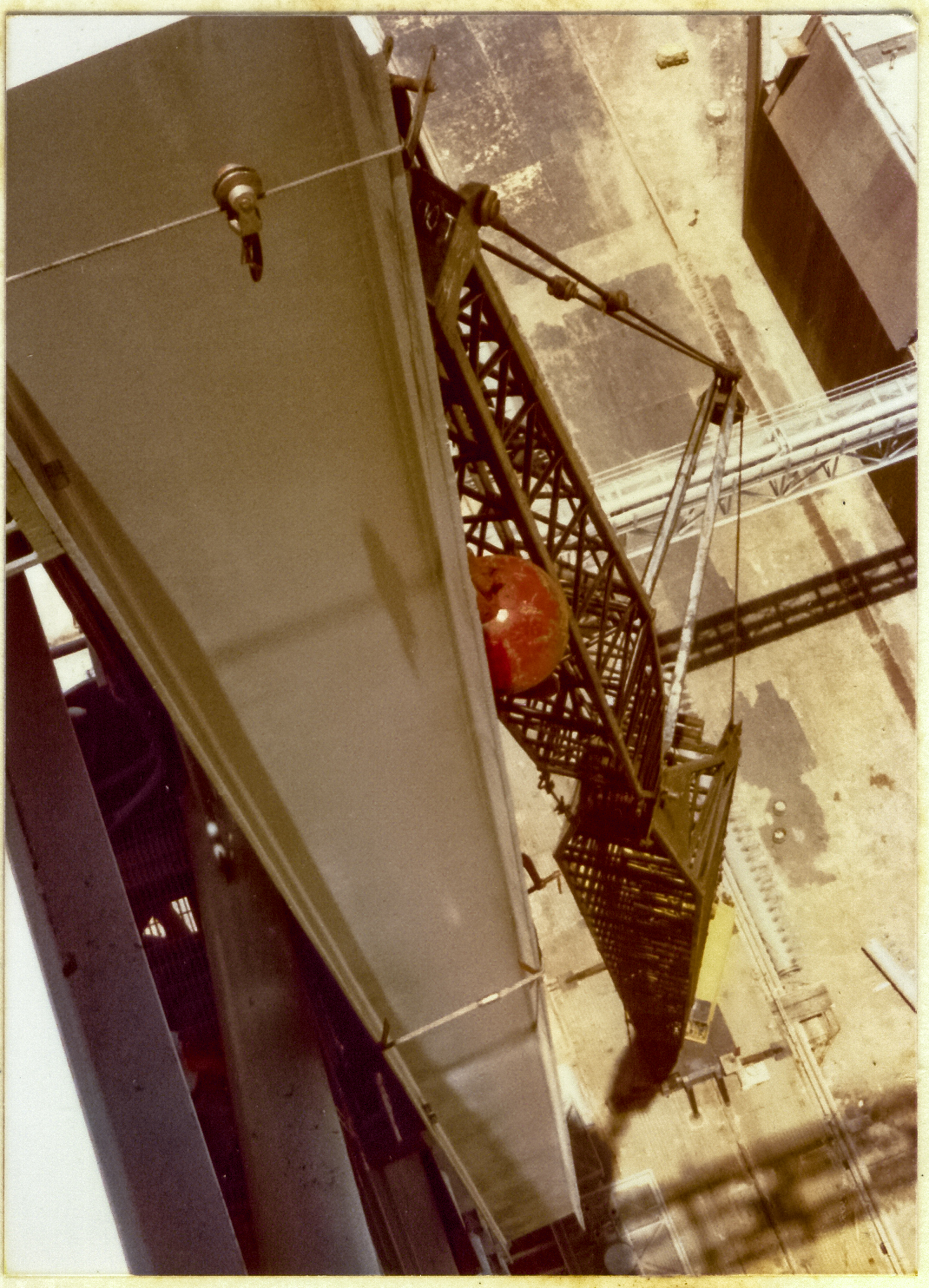
Not much I can say about this shot. It pretty well speaks for itself. One of my favorites, not only from this job, but from anywhere, any time, that I've ever pointed a camera at something, pushed the button, and made it go "click."
Return to 16streets.comACRONYMS LOOK-UP PAGEMaybe try to email me? |